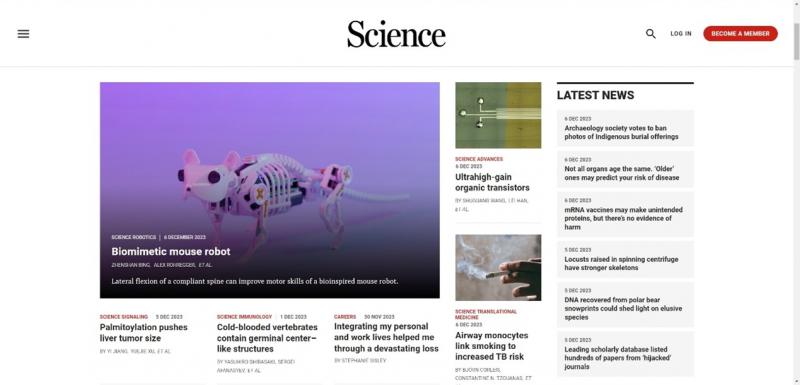Professor Huang Kai's artificial intelligence and unmanned systems research team published their latest research results on mouse robots in Science Robotics
Recently, Professor Huang Kai's artificial intelligence and unmanned system research team in our school published a research article titled "Lateral Flexion of a Compliant Spine Improves Motor Performance in a Bio-Inspired Mouse Robot" in Science Robotics, a top international academic journal. The article was reported on the homepage of Science's official website. This is the first time that Sun Yat-sen University has published a research paper in Science Robotics!

Science Robotics is one of the five journals of Science, with an impact factor of 27.641 in 2022. It is published by the American Association for the Advancement of Science (AAAS) and focuses on multiple interdisciplinary fields such as artificial intelligence and robotics development. Science Robotics was founded in December 2016. As the youngest journal of Science, it aims to disseminate representative research results in the field of robotics, promote the cross-application of different disciplines in robot design, theory and multiple fields, provide the latest cutting-edge technology discussions, and provide insights and guidance on policies, social topics and ethics in the field of robotics. It enjoys a high international reputation and influence.
The research has developed a highly bionic mouse robot. The core innovation of this robot is the introduction of a deformable flexible spine, which greatly improves the robot's movement flexibility and efficiency. This major breakthrough not only promotes the development of the design of legged robots with spines, but also provides new perspectives and possibilities for related research on motion control. One of the corresponding authors of the article is Professor Huang Kai from the School of Computer Science at Sun Yat-sen University. Collaborators include Huang Yuhong, a doctoral student at the Technical University of Munich and a 2017 graduate of the School of Computer Science at Sun Yat-sen University.
This study reveals that a flexible spine plays a vital role in improving the locomotion capabilities of legged robots, especially in enhancing agility. Currently, although quadruped robots have achieved highly dynamic and flexible movements relying on their legs, their movement patterns still show a certain degree of stiffness, which limits their movement efficiency to a certain extent. Therefore, incorporating a flexible spine design into the robot's construction is particularly beneficial for enhancing its agility, especially for small and underactuated quadruped robots with limited size and insufficient power. In this study, researchers designed and demonstrated a mouse robot (Neurorobotic Mouse, NeRmo) that meets neurorobotic standards. The robot has a flexible spine that can bend sideways, significantly improving its walking speed and maneuverability. As a bionic robot mouse, NeRmo simulates the morphology and tendon drive system of a real mouse. First, NeRmo significantly enhances static stability by adjusting the posture in an initially unstable configuration through lateral flexion of the spine. Secondly, this lateral curvature of the spine can effectively extend the stride of the gait, thereby increasing the walking speed. Finally, NeRmo's flexible spine allows for excellent agility when tight turns and fast travel are required. These findings not only deepen our understanding of the spine-based locomotor skills of quadrupeds, but also highlight forward-looking design concepts for more agile quadrupedal robots.
In this study, the research team detailed the multiple effects of horizontal spinal curvature on the animals' motor abilities.
Effects on static stability : Curvature of the spine causes a change in the position of the animal's center of gravity, which is essential for maintaining balance.
Effect on stride length : The curvature of the spine helps adjust stride length by changing the distance between the shoulders and hips.
Effect on turning ability : The curvature of the spine also changes the axis of the hips and shoulders, thus affecting the efficiency of turning.
The research team cleverly applied these theories to robot design, significantly improving the robot's static balance, movement speed, and turning ability.
Experiment 1: Flexible spine bending improves the static stability of the robot
In static balance experiments, the research team demonstrated the unique effect of the spine balance compensation (SBC) mechanism. This mechanism adjusts the center of mass (CoM) through lateral spine flexion, ensuring that the robot remains statically stable despite its initial unstable state. The experimental process is as follows: First, the NeRmo robot is set in a neutral quadruped static contact state with its legs directly under the shoulders or hips. Then, each leg of the robot is lifted up in turn and transformed into a three-legged static contact state. In this state, the raised leg is swung through the full range of motion of the shoulder or hip joint, and the effect of enabling and not enabling the SBC is tested simultaneously. The results showed that without enabling SBC, the robot could not maintain balance in tripod standing because its center of gravity exceeded the supporting base. However, when the SBC is enabled, NeRmo is able to maintain balance effectively. To further quantify the analysis, the researchers monitored NeRmo's pitch and roll angles in a real environment. Even when able to maintain balance, NeRmo with SBC enabled had a 50% reduction in forward lean angle and a 50% reduction in roll angle when raising its front leg. During the hind-leg balance test, SBC reduced pitch deviation by 73% and roll deviation by 80%, effectively preventing the robot from tipping over.
Under the action of the spinal SBC, the robot can maintain the stability of three-legged standing.
Experiment 2: Flexible spine bending improves robot movement speed
In the study of straight-line walking, the latest experimental results reveal a method of using lateral flexion of the spine to increase walking speed. Studies have shown that spinal-assisted gait exceeds traditional gait in speed. The paper shows in detail the walking speed at different gait frequencies, and these data were obtained in a real environment. Six different gait configurations were tested experimentally, covering the ideal trot with and without spine (labeled as “trt,s” and “trt,ns”, respectively), the walking trot with and without spine (labeled as “walk,s” and “walk,ns”, respectively), and the lateral walking gait with and without spine (labeled as “lat,s” and “lat,ns”, respectively). The study showed that in a large number of experiments with different gaits at different frequencies, the robot's speed increase ranged from 8% to 17%. The research team observed that spine-assisted gait resulted in a longer stride than conventional gait. Compared with the straight trajectory of standard gait, the trajectory of the swing leg in spine-assisted gait shows a unique curved morphology, which is mainly caused by the curvature of the spine. These real-world results not only validate the results of the simulation tests, but also show the same trends.
Under the action of the spine, the robot effectively improved its movement speed in various gait tests.
Experiment 3: Flexible spine bending improves the robot's turning ability
In this study, the team demonstrated the enhanced turning ability achieved by the introduction of the spine. The experiments examined three turning strategies: leg-based turning, spine-based turning, and hybrid turning. In the leg-based turning strategy, the robot controls the motion by adjusting the length of the stride on each side, resulting in an asymmetric contact force distribution that generates a yaw moment around the center of gravity. In contrast, spine-based turning strategies use the lateral bending of the spine to guide the robot, an approach similar to the natural behavior of some organisms. A hybrid turning strategy combines both leg-based and spine-based approaches. The experimental results show that among all tested gait frequencies and types, spine-based lateral bending turns show the fastest speed regardless of the turning trajectory, which is about 20% to 30% faster than leg-based turns. The speed of the hybrid turning strategy is also better than that of pure leg-driven turns and only slightly worse than that of pure spine-driven turns. In practical applications, the hybrid turning strategy achieves the best minimum turning radius, which is about 30% smaller than leg-based turns and 60% to 85% smaller than pure spine-driven turns. These findings not only highlight the importance of spinal curvature in robotic locomotion, but also provide valuable references for future robot design.
The turning action, which is achieved through the combined action of the spine and legs, combines turning speed with flexibility.
Experiment 4: Flexible spine bending improves the robot's overall mobility
In a final experiment, the research team tested the animals on a navigation task in a maze environment. The robot was tested in two configurations, with the spine controller on and off. As shown in the figure, the maze scenario requires the robot to perform a series of walking and turning actions to traverse the maze. To determine the path NeRmo should follow, the researchers used vision sensors to acquire visual data. Experimental results show that, thanks to the spine's enhancement of foot movement, the robot's time to complete the maze was reduced by 30.6%.
With the help of the spine, the mouse robot can complete complex maze tasks faster.
in conclusion
In this innovative study, the scientific research team carefully created the bionic robot mouse NeRmo, which cleverly simulates the efficient operation of the muscles and bones of a mouse when walking on four legs. Its core highlight is a spine that is both soft and elastic, which can not only bear body weight but also stretch and bend flexibly, truly reproducing the function of a biological spine. Unlike common quadruped robots, NeRmo's spine design is simple, flexible and compact, providing a new perspective for future robot spine design. In a series of experiments, the researchers demonstrated the significant advantages of this flexible spine in improving the locomotion performance of small, underactuated quadruped robots, particularly in terms of improving static stability, walking speed, and turning agility. It is particularly worth mentioning that NeRmo can maintain balance even in the unstable state of three-legged contact, fully demonstrating its strong robustness in practical applications. Additionally, NeRmo uses the lateral curvature of his spine to extend his stride, allowing him to move faster. In terms of turning performance, NeRmo's speed is increased by up to 40% compared to traditional leg-motion-based turning, and its minimum turning radius is also significantly improved, demonstrating the great potential of flexible spine in improving the mobility of quadruped robots.
aper download link:
https://www.science.org/doi/10.1126/scirobotics.adg7165
Source: Institute of Artificial Intelligence and Unmanned Systems
Edited by: Tan Xuyan, Wu Xiaohong
First review: Wang Dongmei
Review: Yan Xiaohui
Review and release: Ma Xiao




